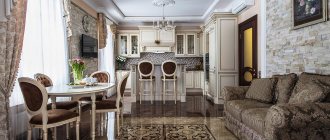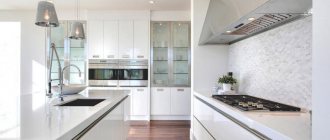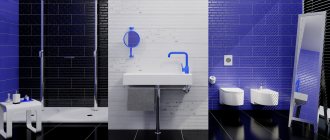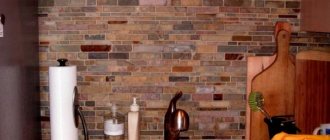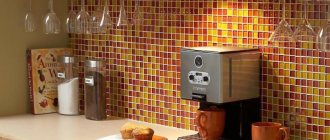SHARE ON SOCIAL NETWORKS
FacebookTwitterOkGoogle+PinterestVk
Due to its aesthetic appearance and unique properties, the undisputed leader in finishing materials is floor tiles for the hallway and kitchen: photos of modern interiors clearly demonstrate this. But how to choose the right tile among the many different offers on the market? Buying flooring is not an easy task that requires a careful approach to its solution. Indeed, to create not only a stylish, but also a high-quality interior, it is necessary to take into account the technical characteristics and features of this material. After reading the article and the proposed photos of floor tiles in the interior, you can easily make your own choice.
Ceramic tiles are one of the most practical types of flooring
Main quality indicators of floor tiles
To make tiles, a mixture of fine-grained white or red clay, sand and natural ingredients is used. Strength is imparted to the finished product by firing in special ovens at temperatures above +1000°C.
White clay tiles are softer than red ones. You can determine the original composition by the shade of the end. If red clay was used, the end is yellow or red. White clay does not stain tiles.
When choosing ceramic tiles for a hallway or kitchen, you need to take into account not only the aesthetic perception, but also the physical characteristics of the product, on which the performance indicators depend:
- strength;
- stiffness coefficient, which is directly proportional to the thickness of the tile;
- thermal conductivity, a high rate allows you to install a warm floor under the base;
- high fire resistance, thanks to which the tiles can be used as cladding for stoves and fireplaces;
- electrical insulation;
- the tile is resistant to chemical media, with the exception of hydrogen fluoride;
- fully complies with the requirements and standards of sanitary control, is not exposed to harmful microorganisms;
- Due to their high wear resistance, the tiles are popular for installation in high-traffic areas.
The wear resistance marking is indicated by the manufacturer on the packaging.
In addition, according to state standards, compliance with the following data is important:
- Wear resistance – up to 0.18 g/sq.m. cm;
- tensile strength – 28 MPa;
- the number of cycles to determine frost resistance is at least 25.
A practical solution for the kitchen
Furniture
When choosing furniture, it is important not to overload the corridor. In addition to wood, it’s great to add forged items. They, coated with black varnish, make you look at familiar surroundings in a new way.
The presence of things designed in the same style will make a minimally filled space complete and harmonious. The presence of texture with chrome elements can add luxury.
If there is a light background, the illumination can be reduced, but dark paint will require brighter light and more than one lamp.
Pros and cons of using floor tiles for the kitchen and hallway
Before choosing flooring for the kitchen and hallway, it is important to become familiar with its strengths and weaknesses. This may affect the choice of material.
Strengths
- The tiles are environmentally friendly; they contain only clay, sand and hypoallergenic components;
- thanks to firing under high temperatures, the tiles have increased strength;
- moisture resistant, can retain water on the surface for several days. This protects it from the appearance of fungus and harmful microorganisms;
- durability - can last for decades with proper care;
- The protective layer protects the tile from external damage and scratches.
- practical, caring for it will not be difficult;
- fire resistant.
Weak sides
When choosing tiles, you need to be prepared for some features of the material.
- The surface of the tile is cold. High thermal conductivity allows you to install a warm floor underneath;
- slippery surface, especially when exposed to water. Therefore, for the kitchen, hallway and bathroom you should choose a material with a special coating;
- low sound insulation, which can be improved by laying an additional soundproofing layer under the base;
- If transported or installed incorrectly, the tiles can break. In addition, during operation, chips may appear from falling metal or sharp objects.
The disadvantages are not that critical. Knowing about these features, you can make the right choice of tiles that will delight you for many years.
Not afraid of fire
Advantages and disadvantages of floor tiles
Tile has a number of advantages over other finishing materials:
- hygiene - tiles are considered the best finishing material for rooms with high levels of pollution. The smooth and even surface is easy to clean, does not accumulate dust and tolerates washing well even with the use of aggressive household chemicals. The latter is a big plus, since the floor in the kitchen and hallway is constantly exposed to moisture, which can contribute to the appearance of mold and harmful bacteria;
Floor tiles of different sizes and colors are used in the modern kitchen interior
- strength - with high-quality laying of tiles, it is able to withstand significant loads from impacts. In addition, it is not subject to mechanical damage and loss of color;
- durability – well-installed tiles can last you up to 50 years without losing their visual appeal;
- moisture resistance – not afraid of high humidity and even flooding;
The combination of black and white tiles is a timeless floor design option
- fire resistance - ceramic tiles do not react in any way to increased temperatures and will not burn in the event of a fire;
- ease of restoration - in case of damage there is no need to replace the entire floor covering. You can easily replace a separate section, returning the interior to its original appearance;
- environmental friendliness - ceramic tiles are a material that is safe for health;
Tiles with bright patterns will become an original interior decoration
- a large selection - numerous options for colors, patterns, sizes, as well as a variety of tile textures make it possible to create not only a practical, but also a visually attractive design.
Specialized online resources will help you get acquainted with a variety of photos of floor tiles for the hallway. Prices for this material can be found on the websites of construction stores.
Ceramic tiles are a durable material - their service life reaches 50 years
But, like any coating, tiles have a number of disadvantages. We list the difficulties associated with laying tiles and options for eliminating them:
- poor-quality installation can lead to cracks, so it is necessary to prepare a flat and dry base in advance;
- tiles have poor soundproofing properties. This drawback can be eliminated using a special layer, which is laid at the stage of creating the screed;
The most popular shapes of floor tiles are square and rectangle
- tile is a rather cold material. But at the same time, the tile has excellent thermal conductivity, so the problem can be solved by installing a “warm floor” system;
- tiles are a slippery surface, so it is better to give preference to tiles with a rough texture.
An example of using tiles in the interior of the hallway of a private house
Types of floor tile shapes for kitchens and hallways
Tiles of traditional shapes go on sale - square or rectangular with an aspect ratio of 1 to 2 or 1 to 3. They come in the form of strips, they are more often used as decoration.
Many collections include only rectangular products that fit effectively into any interior design. You can design the floor in the hallway in the form of parquet or brickwork. With the help of such forms, the accents of furniture arrangement or room zoning are interestingly highlighted. Visually, you can change the geometry: make the elongated area more proportional if the long side is laid in proportion to the larger side of the room.
Tiles of an unusual format look original in the interior: in the form of a polyhedron, with rounded corners, with cuts in the form of a wave.
Imitation of masonry
Interesting and classic design solutions
In most cases, the tiles are monochromatic or have a simple pattern - some kind of uniform texture or a repeating (for ease of adjustment) pattern.
Combination of tiles and laminate
Large tiles visually increase the space
White color makes the kitchen lighter. The glossy surface adds elegance.
But today you can see much more interesting options on sale. For example, a set of tiles can fit into one pattern. However, you should be careful here - if you damage even one part, you will have to purchase the entire set. And the Spanish company Aparici actually released tiles made from recycled skateboards - very bold and modern.
So, we can say with confidence that with the correct selection of tiles and high-quality installation, the owner of the apartment will get rid of any problems with repairs for many years.
Basic dimensions of floor tiles for the corridor and kitchen
Manufacturers produce collections of standard sizes. For small rooms, it would be more practical to use tiles of 20×20, 20×30, 20×25, 30×30 cm. They will not require much cutting, and there will be much less waste during the installation process. A beautiful inclusion will be a pattern of small tiles 10x10 and 10x15 cm.
For large areas, you can choose larger sizes 33.3×33.3, 40×40, 60×100 or 70×120 cm. In the collections, designers select a harmonious combination of different sizes of tiles in the hallway on the floor. Photos of excellent solutions are presented in our gallery below.
Useful service:
Especially for our readers, we offer you to use a convenient online kitchen designer , which allows you to organize the kitchen space to your taste and quickly calculate the cost of the kitchen set.
Interior style solutions
There are many design options for floor tiles. But when it comes to a certain style, it all comes down to a few, but rather profitable options.
Classical
Floor tiles can help bring classics to their most luxurious interpretation, especially if the living space supports it. This is the time when shine will look appropriate, especially in combination with marbled porcelain tiles or classic patterns.
In more modern interiors, you can limit yourself to light natural finishes with several decorative elements that are in tune with the color scheme.
Modern
The visual component of directing is not inferior to the practical one and often draws aesthetics from it. It is worth emphasizing the practicality of the material, as well as its compliance with the geometry of the space.
Matte floor tiles of light colors with a uniform or structural surface will harmoniously fit into such a corridor. But for interesting experiments, the modern style is suitable, for example, a black glossy floor surrounded by white walls.
Scandinavian
The dominant color in a Scandinavian interior is white, so you can stop overthinking it and continue it at the base of the room. In addition to standard square fragments, you can pay attention to tiles of different shapes with geometric patterns or lay them out in the form of bricks. Natural textures are also suitable for hallways.
Loft
Inspired by an industrial aesthetic, loft is the perfect canvas for a variety of combinations.
You can purchase wood, stone or even concrete floor tiles. Against the background of brick walls, detailed fragments of different shapes look interesting, contrasting with other compositional elements.
High tech
Despite their commitment to high technology, high-tech does not shy away from traditional solutions.
Here you can use large massive blocks with deep texture, matte products or those that softly reflect light.
The colors are strict, natural, continuing the monochromatic palette characteristic of the style.
Technical characteristics of floor tiles
In order to avoid any unpleasant surprises during operation, it is important to choose the right coating, taking into account the purpose of the room and the physical characteristics of the material. Only after this can you proceed to selecting a specific collection. All parameters are indicated by manufacturers on the packaging with certain symbols and numerical values.
Porosity of material
This is the main indicator. Water absorption for unglazed products should not exceed 3.5%, for tiles with a glazed surface - no more than 4.5%. As a rule, manufacturers produce products with an indicator significantly below the permissible level.
Frost resistance is directly related to porosity. Tiles with porosity below 3% can withstand sub-zero temperatures. The reduced moisture content protects it from freezing. Such products are marked B I.
Hardness and wear resistance
According to the perception of external loads, tiles are classified into the following categories:
| Category | Characteristics |
| 0 | Recommended for use on walls only. |
| 1 | Used for low traffic areas. |
| 2 | For domestic use only, excluding corridors, balconies and stairs. |
| 3 | Recommended for use indoors for domestic and commercial purposes. Exception for foyers, stairs and corridors. |
| 4 | Recommended for high traffic areas. |
| 5 | The highest wear resistance class, used for areas with heavy traffic. |
Mechanical (strength) characteristics
When choosing tiles for the hallway floor, you should remember that during operation they will be constantly exposed to mechanical stress. The service life of the material is determined by the value of surface strength according to the Mohs scale.
The tile surface is exposed to various minerals. The surface hardness value is considered equal to the previous scratch formation value.
| Index | Material |
| 1 | Talc |
| 2 | Gypsum |
| 3 | Calcite |
| 4 | Fluorite |
| 5 | Apatite |
| 6 | Feldspar |
| 7 | Quartz |
| 8 | Topaz |
| 9 | Corundum |
| 10 | Diamond |
Important! On a glossy surface, scratches are more visible, so for floors with high traffic it is more rational to choose matte surfaces.
In addition to the surface strength indicator, manufacturers indicate the class of resistance to chemical compounds. The classification is divided into 5 classes. The AA marking is intended for tiles that are resistant to external influences. For marking D, in areas with heavy wear, the coating will quickly lose its original appearance.
Security requirements
Any material used for renovation work in an apartment must be safe for people. First of all, this is compliance with fire safety standards. The tile is resistant to fire, it does not deform and does not emit toxic substances.
Secondly, friction. Manufacturers classify the degree of slip into 4 categories. Marking 0 is considered dangerous. For areas with high traffic, you must choose category 0.75. To increase the friction force, a special coating – corundum – is applied to the surface.
Specifications
What tiles look like in different styles
Thanks to its variety, ceramic coating is suitable for all styles.
Modern
Style is based only on practicality. But don’t forget about the attractive component. The design should look good and fit the overall concept of the room.
Based on practical decisions, only the most affordable materials are selected. Also for the same reason, a dark design option is more justified. But finishing in a light style is allowed if the concept does not require it. There are no restrictions on the palette.
For finishing, you can choose monolithic blocks or with a clear geometric pattern. It is allowed to dilute large elements with small inserts. The essence of the idea is the unification of opposites.
For modern style, any experiments are acceptable. You can abandon generally accepted norms and lay out the floor with small light tiles, surrounding it with dark walls. An interesting option with a black floor and white walls. You can try to assemble a multi-colored mosaic on the surface. The main thing when finishing is to be guided by practicality.
Minimalism
For minimalism, choose one tile in a basic shade. The rigor and simplicity of minimalism should also be shown in the flooring.
Loft
Thanks to its variety, ceramic coating is suitable for all styles.
Lofts prefer (often distressed) faux wood floors in the hallway. Minimalism is characterized by tiles with a laconic pattern: white, gray, with the texture of concrete. Floor products imitating natural stone emphasize the sophistication of the classics.
The photo shows a loft-style hallway with black and white patterned tiles.
Provence
For a stylish interior, a light floor made of small bricks and figured fragments is suitable. This design takes on the features of lightness and romanticism inherent in the casual style. If you don’t want to focus attention on the floor, take tiles that imitate existing parquet in a light shade.
Scandinavian
In the Scandinavian style, patchwork is now more popular. Adherents of high-tech choose a modern design for the hallway floor, emphasizing the smooth lines of furniture and decor.
If you adhere to traditions, the style involves the use of a large number of white surfaces. This is due to the fact that in Scandinavian countries there is no sun for more than half the days of the year. Therefore, light glossy surfaces with a minimum of ornaments and designs are popular.
The ability to diffuse low light is important in small, cramped hallways. Therefore, in narrow hallways the use of white Scandinavian style is completely justified.
But you can give preference to light brown tones. In this case, the tiles are selected to imitate wood. The floors are tiled with brown tiles, and one of the walls is tiled in the same color. It is best to take the one with furniture. The remaining surfaces remain as light as possible.
Classic
The classic interior uses light colors, glossy surfaces and natural materials. For a stylish setting, choose marble tiles with gold or silver embellishments, bold patterns and a vibrant appearance.
Floor tiles for the corridor and kitchen: photos of the main layout methods
Laying methods depend on personal preferences and the selected collection. The design of some materials is luxurious in itself and does not require complex installation methods. For a simple format, you can choose an unusual way, thanks to which the tiles will sparkle in a completely new way.
There are 6 main designs for laying tiles on the floor in a hallway or kitchen.
| Photo | Laying method |
| Traditional installation - performed parallel to the wall surfaces. This is the most common method due to its ease of installation and minimal waste. | |
| Diagonal - laying begins at an angle of 45°. For this method, square tiles are used. The main advantage is the visual expansion of space. The disadvantages include a large amount of waste. | |
| With offset - similar to brickwork. This method is suitable for rectangular and square floor tiles for the hallway and kitchen. You can perform an offset for both traditional and diagonal laying. | |
| Parquet - in the form of a herringbone is suitable only for materials of rectangular size. A coating made from longer strips will look most interesting. | |
| Combined installation method - several techniques are combined. For example, tiles are laid along the perimeter in the traditional way, in the center - diagonally. Well suited for large areas. | |
| Modular installation is carried out arbitrarily in the form of a pattern. It is necessary to make a preliminary sketch of the coating in which the shades can be combined. Manufacturers produce ready-made modular collections. |
This is interesting! Tiles of different colors and shades can be laid in a checkerboard pattern, in the form of ornaments or patterns. It will be a bright and attractive accent in the room.
Zoning the floor with different tiles
Zoning the floor in the interior with different tiles.
Connecting several rooms in one space requires visual differentiation. You can do this by decorating the floor. It is worth using different tile tones in segments. They should not be very different, but even so, boundaries will be visually created. You can use not only color, but also design and texture.
Zoning the kitchen and living room.
When the corridor and kitchen do not have a large area, it is worth connecting them to increase useful meters. This will allow you to place the necessary elements conveniently. Choosing tiles is an important step. It is worth taking into account the color scheme, durability, practicality, and strength. Then the product will last a long time.
Design option with space zoning.
Combining floor tiles with other coverings
By combining coatings you can solve several problems at once. Place tiles on the floor in the hallway only in the area of the entrance door; for the kitchen it is more practical to allocate a work area. This will visually divide the area into zones. A beautiful combination can be made with both laminate and linoleum. The result will be a spectacular decoration of the entrance area.
As a rule, the color chosen is a different color from the second coating. The alignment can be done in a straight line, curved, or in the form of an angle. In addition, the tile section can be located on some elevation in the form of a small podium.
It is important! For safety reasons, the elevation should not exceed 5 cm from the level of the main covering.
The curvilinear combination must be in harmony with the interior details. For example, you can mirror a line on a suspended ceiling.
Combination with laminate
Advantages of design
The first impression of the apartment is created by the room at the entrance. Of course, when entering a house from the street, you want to be imbued with a positive attitude. Reflections of metal, shimmering pearls, silver highlights and other shades help to create visual accents in a gray hallway.
After all, the main purpose of such a tone is to instill calm and confidence that everything is in order here. But to add sophistication and elegance, it is best to use original shapes and lines. Mirrors look great - a luxury item on a gray wall.
A stylish console and wooden frame will only emphasize their appropriateness. The only rule is to maintain a balance of light and dark undertones. The advantage of the grayish color is that it is completely non-staining. And this is a significant advantage next to the front door. In addition, too bright sun is somewhat softened by a light palette and does not fade for a long time. A profitable investment.
Choosing floor tiles for the hallway and kitchen
The huge range of products makes choosing very difficult. It is necessary to listen to the advice of practicing designers who will help you choose the best floor covering option. A correctly chosen collection will emphasize the advantages and hide small errors in space.
Color selection
When choosing a color, you must take into account the basic design of the room and the basic techniques of professionals:
- For a small space, you should choose light shades that will visually expand the boundaries;
- Light floor tiles are recommended for dark rooms with windows facing north or without windows. In bright sunlight, a dark coating will look interesting;
- The classic combination of white and black tiles is always relevant. For installation, choose a checkerboard pattern in a diagonal layout or in the form of diamonds;
- Shades of gray, beige or brown are optimal for a hallway or kitchen;
- A glossy surface is more difficult to care for than a matte one;
- stone or wood tiles in the interior look quite stylish and are suitable for any style direction of the room.
Classic combination
Selecting a texture
The kitchen and hallway are high-risk areas. Possible contact with water, drops of grease in the kitchen, dirt from the street in the hallway. You should choose tiles for the floor in the hallway or kitchen with a slight roughness. Please remember that large recesses can accumulate dirt. You can also choose a glossy surface, which, thanks to the coating, is more durable and better retains moisture.
Seam color
The most vulnerable place on the floor is the seams. It is not recommended to use light-colored grout for floor tiles in the hallway and kitchen. In a short time, not a trace will remain of its former beauty. The shade of the grout must be the same color as the tile. The contrast doesn't look very nice.
Dark seams are not suitable for a light coating. For such cases, you should opt for epoxy grout. Its cost is somewhat more expensive than usual, but its strength is much higher.
Related article:
Kitchen floor tiles are considered one of the practical and sustainable coverings . The photos and prices presented in our review will allow you to choose the appropriate option.
Tile layout
Original tile layout in the hallway.
In addition to choosing the right tiles, it is important to decide on the layout method. Among them:
- Standard method. Available, representing installation in regular rows. Suitable for large tiles;
- Brick. Differs in offset. Suitable for rectangular shape. It is better to use products of different shades;
- Parquet. A similar installation is used for materials imitating wood;
- Modular. It is complex and requires skill when installing. The drawing is located in the center, surrounded by other details;
- Diagonal. Allows you to hide wall imperfections, including lack of parallelism. Installation skills required. Allows you to expand your boundaries visually.
Diagonal tile layout.
Proper use and care of floor tiles
Tiles on the floor do not require special care. It is enough to wipe it daily with a damp sponge, after removing the sand with a broom or vacuum cleaner. To remove stubborn stains, you can use a cleaner with a universal composition. After cleaning, wash the surface with clean water. Here are some more effective ways:
- To remove heavier stains, you can use a stiff brush with plastic bristles. Metal scrapers may leave traces of rust on the surface;
- soap compositions are also not recommended, as the surfaces soon become dull;
- You cannot use several products with different compositions at once.
You should know this! Tiles do not like compositions that contain acid or ammonia. They destroy the seams. In addition, such fumes can be harmful to health.
You can use an old toothbrush to clean the grout. To clean heavy stains, use special plumbing products. Hard water stains can be removed with vinegar or special anti-limescale agents.
Plastic bristles only
Types of floor tiles in the hallway
The main options are ceramic, quartz vinyl tiles and porcelain tiles. The first grade is classic, with good hygiene and durability. The second option is an improved multi-layer material. The third subspecies is distinguished by its granular structure and decorative properties.
There are also alternative flooring options for the hallway. Clinker tiles, for example, are known for their high resistance to low temperatures. Terralga is white in color, making it suitable as a basis for drawings.
Terracotta has a brick tone and is an excellent option for an antique style. Metlakhskaya - one-time cooking of unglazed pressed tiles. It is completely painted, so the structures are especially durable. To finish the floors in the corridors, solid and porous tiles are used, as well as using single- and double-firing technology.
Ceramic
The traditional and most common type, and not only for the floor in the hallway. It is made of baked clay, which gives the fragments wear resistance and at the same time strength. However, this does not apply to strong impacts, which can lead to cracking.
Temperature changes in ceramic tiles are also not a problem, as they usually maintain a stable cold state, which will cause inconvenience for those who like to walk barefoot on the floor.
With its help, you can realize almost any idea: be it variegated colors, unusual shapes, intricate patterns, relief texture or minimalist uniform coverage.
Gypsum
Often gypsum options can be found in the form of cobblestones. For fans, we hasten to note that this type can only be placed on walls.
Porcelain tiles
Refers to extra-class products with increased strength. Porcelain tiles are made from various mixtures of crushed stone, high-quality clay and natural dyes, available in a wide range of shades.
This is a low-porous material that practically does not absorb moisture, unlike ceramic tiles, which are not so ideal in this parameter. However, the installation complexity is not much different. It also meets other requirements perfectly. The main disadvantage is the high cost.
Quartz vinyl
The construction industry has introduced an improved version of tiles that is not afraid of temperatures, loads and detergents. The composition of this material, in addition to quartz, includes stabilizers, plasticizing compounds, pigments and vinyl, which give the product strength, ductility and a variety of shapes.
Despite the presence of artificial components, quartz is considered safe for human health, but in the corridor it does not play such an important role due to the occasional use of space. If necessary, you can easily replace several blocks without damaging the overall composition.
Disadvantages include a lot of fragments and the need for perfect alignment of the base - even small unevenness will greatly affect the movement.
The main nuances of laying floor tiles yourself
Before starting work, it is necessary to review all the material to determine the presence of factory paint defects and the absence of chips. Then you should mark the area taking into account the size. Professionals advise starting installation from the middle of the area, this way you can get a beautiful, symmetrical pattern. This applies to traditional styling.
Let's look at a simple example of diagonal installation on the kitchen floor:
| Photo | Description of work |
| The wall surface should be protected with 4 cm wide masking tape. | |
| The solution is mixed according to the manufacturer's instructions. | |
| Each product must be lined diagonally with a wax pencil to make it easier to maintain parallelism and perpendicularity. | |
| It is necessary to mark an indentation from the wall by the size of the tile; this will visually increase the area of the room. | |
| Tile adhesive is applied with a notched trowel to an area of about 1 square meter. m. | |
| Laying starts from the corner diagonally along the marked marks. | |
| All rows are laid in the same way. | |
| It is necessary to install mounting crosses between the rows to maintain the evenness of the seams. The installation is periodically checked with a level. | |
| The seams are cut with a spatula, the dust must be removed with a rag. | |
| After installation, remove the masking tape. | |
| Finished floor. |
A more detailed process can be seen in the video:
Instead of mounting crosses, you can use a special DLS system, with which you control not only the seams, but also the uniformity of the solution and the unevenness of the base. A detailed master class of the modern system is presented in the video:
DLS system
Design Features
How to choose kitchen tiles based on color and style is an important question for those who want the interior to look cohesive. It should suit the surroundings and match the color of the furniture and walls.
The floor should not be too bright and catchy (if, according to the design idea, the emphasis is not on the floor).
Product format
The standard option is square. With its help, you can lay out a variety of patterns and alternate colors. An interesting solution would be to divide the room into zones by laying tiles of different colors. The texture and material must be the same or close to each other.
An interesting option is rectangular tiles, which will visually lengthen the room and make it thinner. Allows you to simulate concrete or stone masonry. Polygonal, round or diamond-shaped tiles will add brightness and style to the design.
Style and colors
When answering the question of how to choose the right tiles for the kitchen, special attention should be paid to the color scheme. Optimal color options for kitchen flooring:
- White. A universal tone that will not be difficult to match with tiles and baseboards. Suitable for minimalism, hi-tech, loft style. Visually expands the room. Can be replaced with cream and powdery shades.
- Blue. It should not be too bright; it is better to give preference to a milky blue or soft blue shade.
- Grey. A standard option that will not set off the color of the walls and pull the emphasis onto itself. Gray comes in a variety of shades on the market, from light to smoky and ashy.
- Green. Goes well with walls of sand, brown, yellow shades.
- Brown. Imitation of wood or natural parquet. Wood is available in different colors, each of which can be skillfully integrated into the interior.
Degree of soiling
Preference should be given to plain or contrasting tiles so that the coating does not look pretentious.
If the interior requires complex patterns and textures, it is better to choose tiles that imitate wood or porcelain stoneware.
Layout
There are several layout options:
- “Seam to seam” - run parallel to each other. Standard layout, easy installation.
- The chessboard is laid in the standard way, but two contrasting colors are used, which alternate with each other.
- In a running start - imitation of brickwork. Suitable for rectangular tiles, it is advisable to use tiles of the same or similar shades.
- Diagonally – allows you to create an interesting pattern; it is recommended to use contrasting or related colors.
Wood-effect floor tiles or ceramic parquet
Allows you to create the illusion of parquet. It is cheaper than natural wood, but in appearance it is not much different. Often rectified and laid without visible seams. Suitable for minimalism, hi-tech, Provence style.
Stone effect floor tiles
Tiles that imitate stone are easier to install than natural materials. Plus, it doesn't look as rough and looks more attractive. In terms of strength, of course, it is inferior to natural granite, but has a number of advantages over it.
Modern technologies make it possible to create tiles that imitate the characteristic pattern and texture of granite, quartz, and marble.
Photo catalog of kitchen design with floor tiles
So, armed with all the tips, you can start choosing tiles for the kitchen floor. As examples, we suggest you pay attention to the photo gallery of interesting and non-standard solutions for laying tiles.
Hardness and wear resistance of floor tiles
There are two more very important indicators that you should pay attention to.
Hardness is measured according to the Mohs school and can range from 3 to 9. The higher the number, the better the material will resist scratches and other minor damage. Of course, such material is more expensive.
We should not forget about wear resistance - in fact, it determines how many years the material can last without losing its attractive appearance. It can belong to class from 1 to 5. The indicator is checked in laboratory conditions, for which water, corundum powder, sand and other aggressive objects are used.
Interesting designs for laying out tiles in the hallway on the floor: photos of interesting solutions
The gallery presents stylish techniques for laying floor tiles for the hallway and photos of works on techniques for combining different coatings.
Kitchen floor requirements
The flooring must meet certain requirements of the room where food is prepared. These are wear resistance, resistance to mechanical influences, detergents, preparations containing chemical reagents, moisture resistance. You can get acquainted with all the characteristics in more detail in the article - ceramic facing tiles, which says which tile is suitable for flooring, its symbols, etc.
All this is dictated by the fact that most often all members of your family are in the kitchen when eating; the housewife is busy cutting up food and preparing food. In the kitchen, something can fall on the floor, break, or spill, including something containing fat, etc. That is why most often we choose ceramic tiles. Choose one with a rough surface to avoid slipping on a wet surface.
Where can you buy floor tiles for the kitchen and hallway: prices, catalogs
To purchase floor tiles for the floor in the hallway or kitchen, you can visit the manufacturers' branded stores, where all modern collections, complemented by interesting patterns, are presented at exhibition stands. The consultant will help you correctly lay out the layout using a special program, and will also calculate the amount of material.
The tiles should be taken with a small reserve at once, about 10% of the total quantity. In case of damage or defects during installation, it will be difficult to choose the shade in the store. Lots may vary in color.
The choice can also be made online. The layout and counting program is publicly available on the websites. The price in online stores differs from the manufacturers’ price lists for the better.
How to choose the right floor tiles for the hallway and kitchen
The Christmas tree looks simply gorgeous.
We should not forget about external beauty. After all, the design of the room is very important.
Therefore, the choice of suitable material must be approached very responsibly, taking into account various nuances - from decorative to practical:
- In terms of color, the best choice for cramped kitchens and hallways (and in Khrushchev-era buildings, which make up the majority of the housing stock, they are exactly like this) will be light, soothing tones - light green, yellowish, beige.
- According to the design - it can be either geometric or more elegant - it all depends on the taste preferences of the customer.
- In terms of size, small ones are more convenient to install, but it will cost more. Therefore, in most cases, customers prefer large ones - at least 10x10-15x15 cm.
- According to the intended purpose - it is best to choose specialized floor tiles - they have higher wear resistance. But a universal one would also be a good choice - it is cheaper and if it is used for installation in a house or apartment, and not in a public place, it can last for more than one year.

